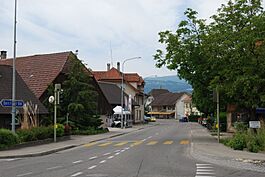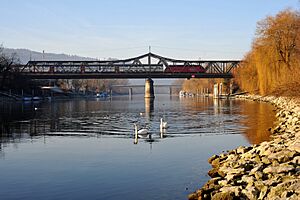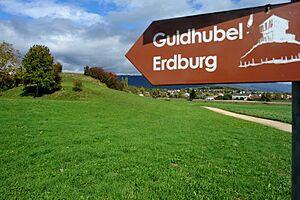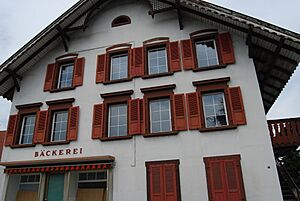Aegerten facts for kids
Quick facts for kids
Aegerten
|
||
|---|---|---|
 |
||
|
||
| Country | Switzerland | |
| Canton | Bern | |
| District | Biel/Bienne | |
| Area | ||
| • Total | 2.16 km2 (0.83 sq mi) | |
| Elevation | 437 m (1,434 ft) | |
| Population
(Dec 2020 )
|
||
| • Total | 2,210 | |
| • Density | 1,023/km2 (2,650/sq mi) | |
| Postal code |
2558
|
|
| Surrounded by | Studen, Jens, Port, Brügg, Schwadernau | |
Aegerten is a town in the Biel/Bienne area of Switzerland. It is part of the Bern canton.
Contents
Aegerten's Past: A Look at History
Aegerten was first mentioned in official papers in 1225. It was called villa Egerdon back then.
Ancient Roots: Roman Times
There has been a village here since at least the late Roman era. It was located on a major Roman road. This road went from Aventicum to Petinesca and then over the Pierre-Pertuis pass to Basel. A bridge was built across the Zihl river around 368–69 AD. The remains of this old bridge have been found near the Bürglen village church. They were also found on the banks of the Flur island in the river.
Medieval and Later Eras
Not much is known about the village after the collapse of the Roman Empire. More information appears starting in the Late Middle Ages. By then, Gottstatt Abbey owned a lot of land in the village. In 1388, the city of Bern took over the village. In 1393, Aegerten became part of the Nidau area and the Bürglen church parish.
Aegerten stayed a small farming village for a long time. This changed in the 18th century. People started earning extra money from shipping on the Zihl river. They also found seasonal work in the nearby Principality of Neuchâtel.
Modern Growth and Connections
Even with four bridges, the village was quite isolated. It was not connected to the growing Swiss train and road networks in the 19th and early 20th centuries. However, the nearby town of Biel started to grow in the 1950s. This led to Aegerten finally developing into a commuter town. It then became connected to the Swiss Federal Railways network.
Exploring Aegerten: Geography and Location
Aegerten covers an area of about 2.1 square kilometers. A large part of this land, about 37.3%, is used for farming. Forests cover about 28.1% of the area. Buildings and roads make up about 29.0% of the land. Rivers and lakes account for about 5.1%.
Land Use and Natural Features
Industrial buildings take up 2.8% of the total area. Homes and other buildings cover 15.2%. Roads and other transport areas are 5.5%. Parks, green spaces, and sports fields make up 4.1% of the land. Most of the forested land is dense forest. Some areas also have orchards or small groups of trees.
For farming, 25.3% of the land is used for growing crops. Another 9.2% is used for pastures where animals graze. A small part, 2.8%, is used for orchards or vineyards. All the water in the town is flowing water, like rivers.
Town Layout and Neighbors
The town is located on the right bank of the Nidau-Büren Canal. Aegerten has grown together with its neighboring towns, Brügg and Studen. It includes the original villages of Aegerten and Bürglen. It also has newer housing areas called Tschannenmatte and Schüracher.
In 2010, Aegerten joined a new administrative area called Verwaltungskreis Biel/Bienne.
Aegerten's Coat of Arms
The coat of arms for Aegerten shows a black lion standing on its hind legs. It has a red tongue and claws. A wavy blue stripe goes across the lion. The background color is gold.
People of Aegerten: Demographics
Aegerten has a population of about 1,729 people. As of 2010, about 13.8% of the people living here are foreign nationals. Over the last ten years, the population has stayed mostly the same.
Languages Spoken
Most people in Aegerten speak German. About 90.9% of the population uses German as their main language. French is the second most common language, spoken by 4.2% of the people. Italian is third, spoken by 1.3%.
Population Makeup
As of 2008, the population was almost equally split between males and females. About 49.9% were male and 50.1% were female. Most of the people living in Aegerten were born in Switzerland. Many were born in the same canton of Bern.
In 2011, young people (ages 0–19) made up 18.4% of the population. Adults (ages 20–64) were 60.4%. Seniors (over 64 years old) made up 21.2%.
Living Arrangements
In 2010, there were 263 households with only one person. There were also 37 households with five or more people. Most apartments in Aegerten are lived in all the time. In 2011, single-family homes made up most of the housing in the town.
Population Changes Over Time
The chart below shows how Aegerten's population has changed through history:

Important Historical Sites
The Goldhubel is an important historical site in Aegerten. It was an early medieval earthen fortress. This site is considered a heritage site of national significance in Switzerland.
Aegerten's Economy: How People Work
In 2011, the unemployment rate in Aegerten was 2.54%. This means a small number of people who wanted to work could not find jobs. In 2008, 386 people worked in the town.
Types of Jobs
- Primary Sector: This includes jobs like farming. In 2008, 17 people worked in this area, with 3 businesses.
- Secondary Sector: This includes jobs in manufacturing and construction. There were 198 people working in this sector, with 22 businesses. Most of these jobs were in manufacturing.
- Tertiary Sector: This includes jobs in services, like shops, restaurants, and healthcare. There were 171 people working in this sector, with 42 businesses.
Many people who live in Aegerten also work there. However, more people leave Aegerten for work than come into the town for work. About 18.2% of working people use public transportation to get to their jobs. A larger number, 57.4%, use a private car.
Beliefs and Religions
Based on the 2000 census, most people in Aegerten are Christian.
- About 67.3% belonged to the Swiss Reformed Church.
- About 15.3% were Roman Catholic.
- Smaller groups included Orthodox Christians and other Christian churches.
- There were also people who followed Islam, Buddhism, and Hinduism.
- About 8.42% of the population said they did not belong to any church.
Learning in Aegerten: Education
Many adults in Aegerten have completed higher education. About 63.3% have finished non-mandatory upper secondary education. Also, 16.3% have completed even higher education, like university or a specialized college.
School System
The school system in the Canton of Bern works like this:
- One year of non-mandatory Kindergarten.
- Six years of Primary school.
- Three years of mandatory lower Secondary school. Here, students are grouped by their abilities.
- After lower Secondary, students can continue their education or start an apprenticeship.
Students in Aegerten
During the 2011–12 school year, 122 students attended classes in Aegerten.
- There were 2 kindergarten classes with 27 students. Some of these students were not Swiss citizens, and many spoke a different language at home.
- There were 5 primary classes with 95 students. Similar to kindergarten, some primary students were not Swiss citizens, and many spoke a different language at home.
In 2000, most students who went to school in Aegerten also lived there. However, many residents of Aegerten went to schools outside the town.
Images for kids
See also
 In Spanish: Aegerten para niños
In Spanish: Aegerten para niños









